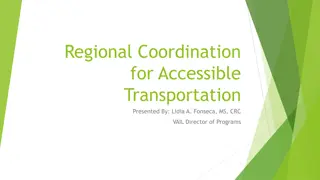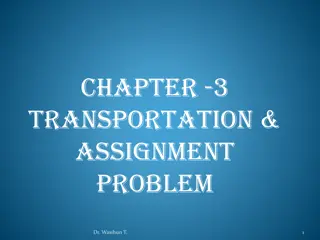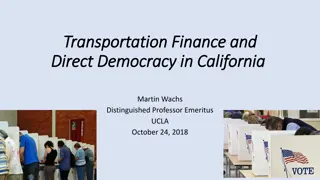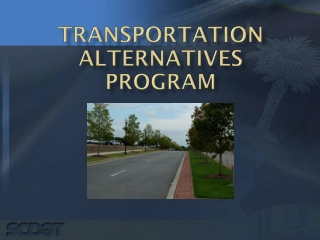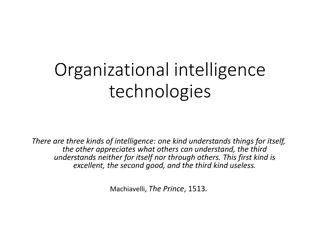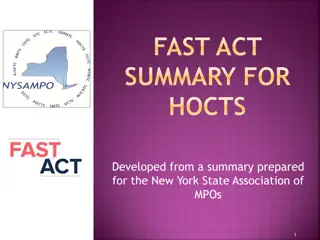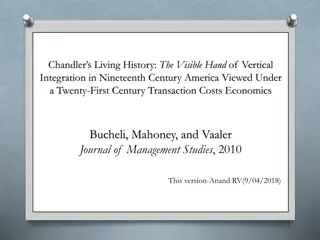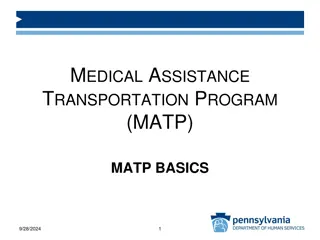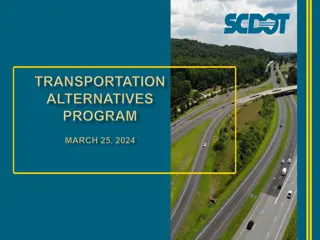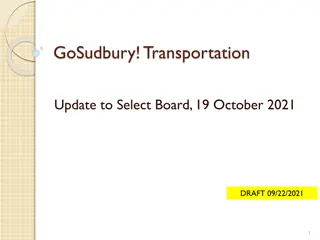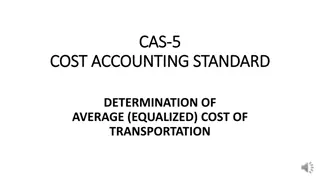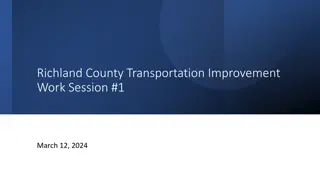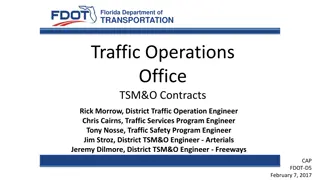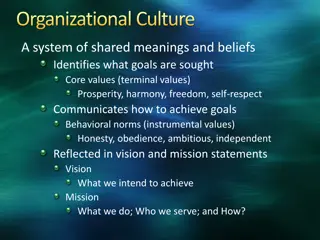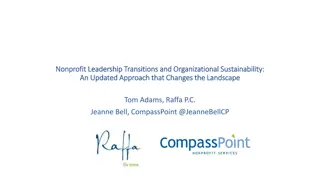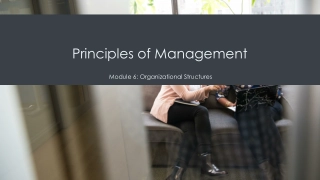Organizational Structures and Strategies in the U.S. Department of Transportation
Explore the three types of organizational structures - project management, functional management, and matrix organization - utilized in the U.S. Department of Transportation. Learn how leveraging contracting expertise and matrix management strategies help optimize resource utilization, meet work priorities, and improve ROI, with a focus on enhancing communication channels and collaboration across different functional areas.
- Organizational structures
- Department of Transportation
- Contracting expertise
- Matrix management
- Resource optimization
Download Presentation

Please find below an Image/Link to download the presentation.
The content on the website is provided AS IS for your information and personal use only. It may not be sold, licensed, or shared on other websites without obtaining consent from the author. Download presentation by click this link. If you encounter any issues during the download, it is possible that the publisher has removed the file from their server.
E N D
Presentation Transcript
U.S. Department of Transportation MATRIX AUDIT WORK Leveraging Contracting Expertise FAEC Annual Conference September 9, 2011 Office of Inspector General
Three Types of Organizational Structures Project Management Functional Management The nature of the work is such that it should be done in quite functional areas. Such as AIG for Air Transportation and Safety or Office of Quality Management or Office of procurement and Contracting. Projectized Management When projects are considered to be critical or time and money are limited the organization is likely to use a projectized structure. Here typically one project manager controls the project. Matrixed Management When the value of varied disciplines makes more sense this leads to the cross-functional orientation of a matrixed structure. The power is more shared. Project managers are responsible for the work, but functional managers still have much control over the resources. 2
Matrix Organization Project organizational structure in which the project manager shares responsibility with the functional managers to assign priorities and direct the work of individuals assigned to the project. In a strong matrix organization, the balance of power over the resources is in favor of the project manager. In a weak matrix organization, functional managers retain most of the control over project resources.(Project Management, Inc. adapted) Example: Functional Structures: AIG Acquisition and Contracting (Functional) Project Manager AIG Surface Transportation (Functional) Project Manager AIG Agricultural Production/Inspection (Functional) Project Manager 3
5 reasons to matrix Leverage resources Tighter budget drives need to leverage resources across OIG to best meet our mission Support 24-month audit plan and other strategic needs Helps OIG meet work priorities Improve return on investment (ROI) Effective utilization of in-house subject matter experts Gain insights and new ideas By working with other OIG offices and DOT operating administrations 4
5 reasons to matrix Congressional Stakeholders Scorecard There is a push to improve the relevancy, timeliness, and impact of our audits. 5
6 6 Strategies to Optimize Matrixing
Matrixing strategy#1 CHALLENGE CHALLENGE STRATEGY STRATEGY Matrixing requires more and new channels of communication Horizontal and vertical communication Hold regular meetings to agree on scheduling, milestones, and status Include matrix partner in all senior OIG briefings Take into account all partners schedules AIG AIG PD PD PM PM Staff Staff 7
Matrixing strategy#2 CHALLENGE CHALLENGE STRATEGY STRATEGY Develop written agreement on common expectations upfront Unclear roles and responsibilities among staff and management at all levels Be specific about roles and responsibilities Define the scope and objectives of the matrixing partner, which they will staff and manage 8
Matrixing strategy#3 CHALLENGE CHALLENGE STRATEGY STRATEGY Each partners ability to manage their own work and staff Inform matrix partner of need in advance to enable proper resource planning (i.e. as part of 24-month audit plan) Specify type of effort needed Number of staff Level of effort (can range from quick assist to joint audit) Develop written agreement on common expectations 9
Matrixing strategy#4 CHALLENGE CHALLENGE STRATEGY STRATEGY Administrative issues Assign TeamMate admin rights to all partners; create additional TeamMate folders to facilitate access Allocate travel money to all partners to facilitate audit management Develop separate TIGR codes or matrixing code Limited TeamMate access Budget allocation for travel TIGR project code assigned to lead team 10
Matrixing strategy#5 STRATEGY STRATEGY Look for opportunities based on overall findings and make decisions, such as restructuring the contract, not awarding an option, or conducting a lease versus buy analysis. Each partner should share in the ROI. Look for new methods (TeamMate) to share or attach savings to each JA. CHALLENGE CHALLENGE Ensuring balanced credit allocation for performance and results 11
Matrixing strategy#6 CHALLENGE CHALLENGE STRATEGY STRATEGY Plan work when partner is available Conflicting work priorities can impact agreed-to schedule Get senior management buy-in on final decisions when work priorities conflict 12
Determining the Right Approach Best Practices Three Roles for Matrixing 13 Expert Role Pair of Hands Role Collaborative
Determining the Right Approach Best Practices Three Roles for Matrixing 14 Expert Role (Client audit group states I have a contracting concern and need expertise. You solve the problem.) Effective when a very technical issue is involved and the consultant has special skills. Client plays an inactive role. Consultant plans, implements, or recommends. Collaboration is not required and two-way communication is limited. Question and answer mode is operating. Client judges and evaluates after the fact. Pitfall No. 1. Problems are rarely purely technical in nature.Most have a people element.
Determining the Right Approach Best Practices 15 If the climate is fear, insecurity, or mistrust, then essential information may be withheld or distorted. Action plans based on invalid data, not all facts, have little chance for success. The consultant needs to get the whole story. Pitfall No. 2. Commitment matters.Recommendations by pure technical experts seldom carry the personal ownership needed (by clients) to deal with difficult management issues. (Increasing client involvement and commitment will add to success.)
Determining the Right Approach Best Practices - Example Expert Role 16 Award of a Contract by a Grant Recipient. The financial auditors believed an improper payment occurred based on a Washington State Auditor Report. The improper payment was not accepted by the Department. We were asked to assist to determine whether procurement laws were violated and whether any recovery was possible. We found noncompliances with state, recipient, and agency regulations. Oversight was lacking and poor decisions were made. The difference between the IGCE (engineer s estimate)and the bib/award amount exceeded 10 percent. About $7.5 million awarded as a deductive change order was not effective in reducing the difference. Actual profit exceeded 30 percent. Mobilization/demobilization of about $7.5 million was unreasonable. Fill materials were advance billed. Refund is being requested.
Determining the Right Approach Best Practices Pair of Hands Role 17 Pair of Hands Role. The client sees the consultant as an extra pair of hands. "I have examined the deficiencies and have prepared an outline of what needs to be done. This works well in situations in which the client retains full control and responsibility. The consultant/expert applies specialized knowledge to implement action plans. The consultant improves upon the outcome. Decisions on how to proceed are made by the client manager. The consultant may prepare recommendations. The client selects methods of data collection and analysis. Pitfalls. The expert is dependent on the manager's ability to understand what is happening and to develop an action plan. If the assessment is faulty then the action plan won't work. (To avoid the big trap, the consultant/expert may ask for time to verify the manager's assessment.)
Determining the Right Approach Pair of Hands Role Example 18 Since you have experience auditing cost accounting systems (CAS), we request your assistance auditing the XXX agency CAS. We have determined that the financial controls are adequate based on the audited financial statements (clean opinion). We have decided that we need you to review the allocation procedures, we will do the audit work. After discussions and meetings the client agreed that we would help write the audit guide by adding tests. We agreed to help interpret test results. Program auditors agreed to reconcile financial system and CAS expenses and revenues. The program auditors accepted 8 of 12 recommended tests for the audit guide. Program auditors agreed to reconcile financial system and CAS expenses and revenues.
Determining the Right Approach Best Practices Collaborative Role 19 Collaborative Role.The procurement experts enters the relationship with the notion that management issues can be best dealt with by joining his or her specialized knowledge with the program auditors knowledge. Consultant and client work to become interdependent. Decision making is bilateral characterized by mutual exchange and respect for expertise of both parties. Data collection and analysis are joint efforts. The parties reach understanding on the nature and scope of expectations prior to implementing problem-solving. Pitfalls. Not as critical as other methods. However, managers who prefer to work with consultants in an expert role may interpret attempts at collaboration to represent foot dragging. Managers who prepare to work with consultants in a pair-of-hands role may interpret attempts at collaboration as insubordination.
Determining the Right Approach Collaborative Role Example 20 ATCOTS (Air Traffic Controller Optimal Training Solutions). FAA awarded the ATCOTS contract to Raytheon in September 2008. The contract consisted of a 5-year base period and 2 option periods (a 3-year period and a 2-year period), with an initial value of $859 million. The purpose of the contract is to provide training support for new and existing controllers and to assist FAA in modernizing its controller training program. Program auditors found. The contractor was experiencing a significant cost overrun for year one. Training was not being delivered to hard to fill critical areas, such as New York City. New methods for delivering training were not being used. Requirements were not correctly defined or were disputed. Experienced controllers were performing on-the-job training.
Determining the Right Approach Collaborative Role Example 21 We established a separate reporting objective: to review the structure and administration of the contract. Agree was to allow acquisition team auditors travel with the program auditors. The Acquisition Team found: The SOW stated that bidders were expected to train 4,000 controllers; however, the contractor found 5,620 required training the first year. The contractor s bid called for reducing training hours by 30 percent for the first three years of the contract from historical hours. However, the source selection Technical Management Evaluation Team issued a red (material) risk that there was 60 80 percent probability that training needs would not be achieved due to the limited instructor hours bid. A risk existed that the contractor did not demonstrate knowledge of the En Route Modernization Automation ERAM. Although the SOW required ERAM training little was proposed; however, 77,326 additional hours were incurred the first year alone.
Determining the Right Approach Collaborative Role - Example 22 Although the SOW stated this was a performance-based contract, requiring new methods for delivering training and more effectively and cheaper; a contract clause required that the contractor must mirror existing training methods. Pilot programs were not implemented. FAA allowed the contractor to design its own award fee measures and did not challenge the measures. The contractor s criteria were already historically achieved or called on FAA to perform much of the work. As a result, although the contract costs overran the baseline by $28 million or 35 percent; the contractor was awarded 91.2 percent of the award fee pool for Year 1. There were no cost controls. The cost incentives (CPIF/CPAF contract)were ineffective. The requirements were so undeterminable that the cost targets could not be re-established. Monetary benefits of about $460 million occurred for recommendations associated with not awarding the option/re-competing and for revising the award fees to make them performance based and linked to program goals.
23 QUESTIONS about matrixing


